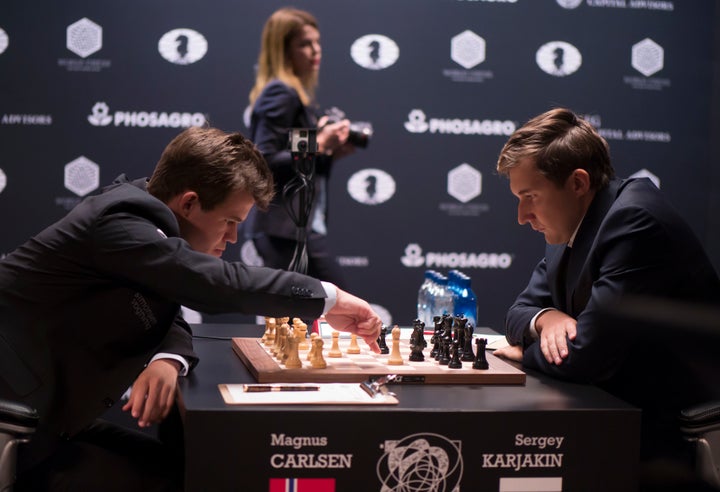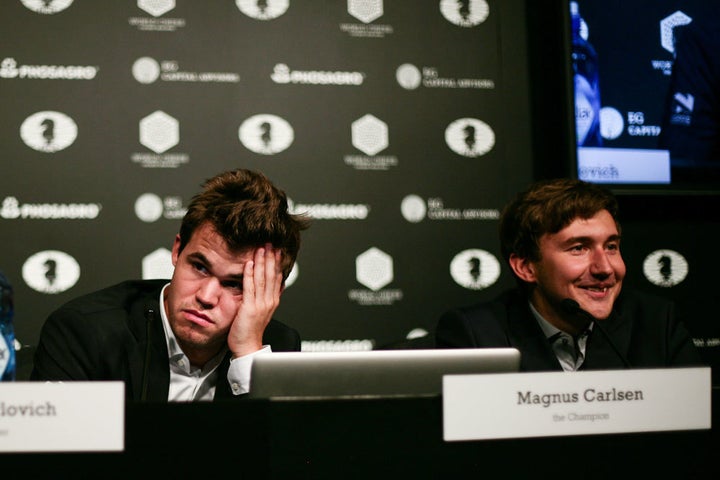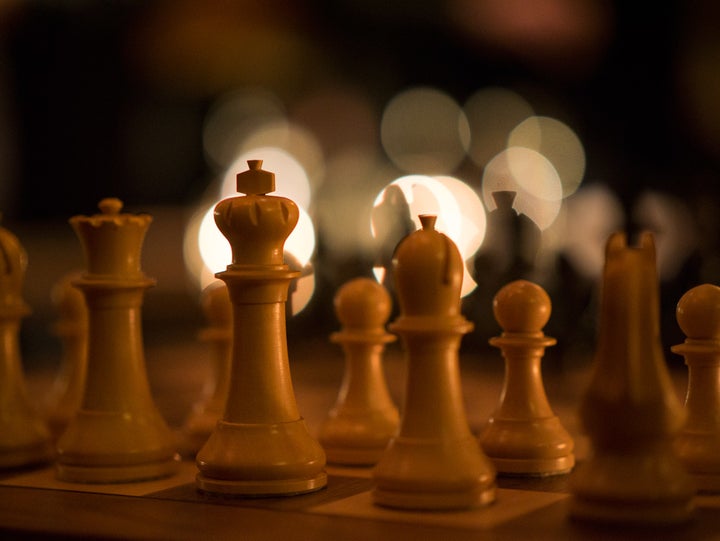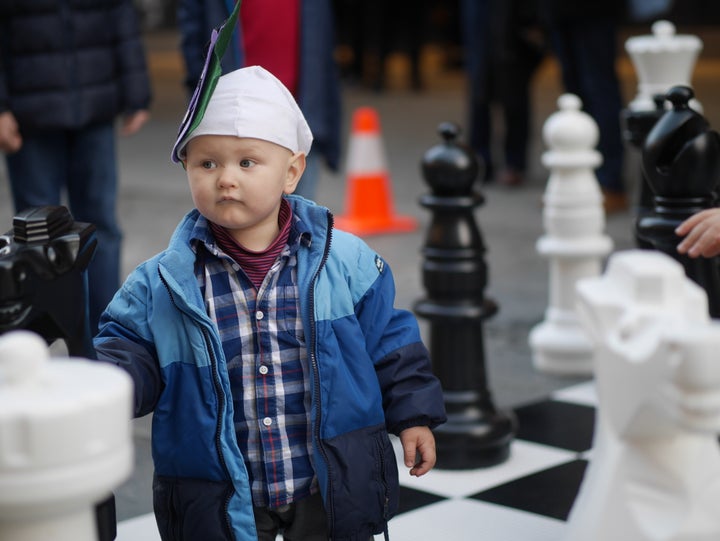
“I think it’s at least 70% that Magnus will win the game,” said Judit Polgar. The world chess champion had just moved his rook to the b5 square, and appeared to be pushing home his 1-pawn advantage against challenger Sergey Karjakin. Polgar, one of the experts offering live commentary, was not optimistic about the challenger’s chances of survival.
“Not fun to be the Russian right now,” said another commentator.
Outside in the spectator’s lounge, the fans were starting to get excited. For the first two days of the world championship match, chess fans arrayed in the Fulton Market Building in lower Manhattan had been forced to endure a pair of relatively staid draws. Now that the commentators were promising blood, the mood began shift. People fidgeted in their seats, waiting for the hammer to fall. They were destined for disappointment.
The consensus would later emerge that Magnus Carlsen’s key mistake was moving his rook to the b7 square on his 72nd move (apparently it would have been better to move it to f7), but there were other subtle errors. So on move 78, the champion offered a draw and the two players shook hands. Magnus is known to be inconsolable when he loses a game, and barely less so when he knows he’s let a win slip away. “Certainly it’s disappointing,” he said afterward.
Like his predecessor Garry Kasparov, Carlsen is also known for his ability to channel his rage and disappointment into a furious counter-attack in his next game. By the third hour on the following day, that seemed to be precisely what was happening. Russian challenger Sergey Karjakin was in an unenviable position. Despite the advantage of the white pieces (which get the first move), he was on the ropes; Carlsen appeared to have a firm grip on the position.
But again, by the sixth hour, things had changed. The live computer evaluation graded the game as more or less equal. It ended as game 3 had, with a handshake and a draw. In game 5 the shoe was on the other foot and it was Magnus who was in trouble. Only through resourceful defense was he able to survive and, once again, it was a draw. In the post-game press conference, a visibly frustrated and exhausted Carlsen frowned and massaged his forehead with his hand. It was painfully clear to the assembled crowd that talking to the public was the last thing the champion wanted to be doing. In response to one question he responded with a curt, “I don’t care.” The audience laughed, although it was clearly not a joke.
By the twentieth move of game 6 on the following day, it again seemed that things were heading for a draw.

A disappointed Magnus Carlsen (and an ebullient Sergey Karjakin) after game 5
Top-level chess wasn’t always so heavy on draws. Back in 1858, Paul Morphy and Adolf Anderssen (generally considered the best players in the world at that time) faced of in Paris. Morphy, a 21-year old prodigy from New Orleans, had been bled with leeches as treatment for influenza and was too weak to stand, so he played his moves from his sickbed. He nonetheless won convincingly. Out of that match’s 11 games, only 2 were drawn.
When the first official world champion, Wilhelm Steinitz, lost his title to Emanuel Lasker in 1894, out of 19 games only four were draws. But at some point in the twentieth century things started to change. When José Raúl Capablanca of Cuba took Lasker’s title in 1921, 10 of their 14 games were draws. When the American genius Bobby Fischer wrested the championship from Boris Spassky in Reykjavik in 1972, it was 11 out of 20. And things took on a whole new flavor in 1984, when Garry Kasparov challenged reigning champion Anatoly Karpov. Over a marathon, 5-month, 48 game match, the players managed a record 40 draws, including, at one point, 17 in a row.
What happened? In short: people got better at chess. Over the decades, the theory and practice of the game developed by leaps and bounds. Players published increasingly complex treatises on attack and defense and endgames and tactics; each new generation understood the game’s subtleties just a little bit better than their parents did. Then the Soviets came along and injected unprecedented state resources into developing chess as a sport; they produced crop after crop of exquisitely-trained, world-dominatingly skillful grandmasters. Chess, which in Paul Morphy’s day had been viewed as barely more respectable than gambling, had become a full-fledged profession, both sport and science.
And one of the chief fields of inquiry within that science was (and is) the opening. This is the term for the first phase of the game, as the players move their pieces forward and set the strategic tone for the coming struggle. For example: it’s known that if white starts with pawn to e4 and black responds with pawn to e5, white’s best reply is knight to f3. But this logic extends outward unendingly. Over the last century, but most energetically in the last few decades with the help of computers, chess players have been analyzing every conceivable opening variation to a depth that would have been inconceivable in Morphy’s time. It’s now well known that the best thing for black to play on move 11 in the Marshall Attack variation of the Ruy Lopez opening is pawn to c6. But if you want to play the Marshall at the world championship level, you’re going to need to know the opening a lot further than move 11. And the chess publishing industry is jam-packed with books that promise amateur players “mastery” over this or that opening, or a “secret weapon” that will allow them to knockout their opponent in the opening without breaking a sweat. Search for “sicilian defense” on Amazon and let your jaw drop.

The problem is built into the design of the game itself. If you look at the starting position on a chess board, it’s obvious that there’s an equilibrium. The white pieces and the black pieces mirror each other perfectly. But so what? After all, at the start of a tennis match, things look pretty symmetrical too. The difference is that in chess it’s much harder to break that symmetry. In tennis the players move about the court in real time. Wind and gravity and muscle contractions conspire to randomize the game. A moment’s lapse in concentration costs you a point. There is no physical equivalent of playing your pawn to c6 on move 11. Chess players simply have greater control over their game.
Of course, eventually every chess game enters uncharted territory. But when the first 15, 16, 17 moves have been so exhaustively analyzed beforehand by both players and their squads of grandmaster assistants, the positions that result are so strategically familiar to both players that the scope for real creativity is reduced. None of this is really anyone’s fault; not the International Chess Federation’s, and certainly not Magnus Carlsen’s. Players at this level have to play what works; it’s no good going in for an obscure and eccentric opening if it’s been proven unsound.
And a draw can be a fascinating game; when two world-class players perform brilliantly against each other, after all, a draw is a just result. In the ’60s when Bobby Fischer published a compilation of his best games he included quite a few hard-fought draws. Grandmaster commentators are always reminding their viewing audience of this fact; after each game of this year’s championship, they’ve been desperate to point out how dramatic some of the draws have been. But the hard truth is that chess fans want decisive results. They want to see one player glorying in victory and the other coughing up blood (metaphorically).
Everyone laments just how alienating this element of championship-level chess has become for the average fan. When I spoke with Andrew Murray-Watson, Director of Communications for Agon Unlimited (the company putting on the event), he pointed out that there’s just not much that can be done without fundamentally altering the rules. “We can’t really avoid that,” he said. “But you know the old adage about there being more possible move combinations than there are stars in the galaxy? No matter how good opening preparation gets and how good opening theory gets, there’s still two or three generations’ worth of surprises… obviously the standard of opening theory and play has gone up significantly since the dawn of the computer age, but I don’t think that means it’s suddenly become a sort of strategic cul-de-sac.”
Compounding the issue is the sheer length of the games. This is nothing new; top-level chess has always been a marathon, not a sprint. But when a game ends in mutual submission the fact that the audience has been watching for seven hours makes the anti-climax that much more disappointing. It’s possible that shorter games could alleviate the problem; not only do they reduce the time commitment required of spectators, but they randomize the game to a certain extent by forcing players to make their decisions more quickly. Chess, though, has always been dominated by a form of long-game-purism: “classical time control” as it’s called, is seen as the creative apex of the sport.
Many people, Murray-Watson included, don’t think these criticisms are completely fair. “I think you’re doing the audience a disservice by saying that it’s so long and therefore that’s a bad thing,” he told me. “I think it’s a misconception that everything that’s entertaining has to be instant, and has to be fast and rapid-moving. We’re never going to be American Football. I’m British, right? I see chess a bit like test match cricket. Test match cricket goes on for five days.”
“Will everyone sit there for six hours and watch the online broadcast? Probably not. But a lot of people will be sitting at work and having it on in the background.”
In 1996, Bobby Fischer (by that pointed retired from the game and living as a recluse) proposed a variant of chess called “Fischer Random”. The idea was that the arrangement of the pieces would be scrambled at the start of each game, thus preventing players from preparing their openings. They’d have to play actual chess from move one. Fischer Random (also known as Chess960, a reference to the possible number of starting positions) has gained some popularity in niche events, but shows no real promise of displacing its traditional forebear. For the time being, it seems, the draws will continue.
On Sunday Magnus Carlsen and Sergey Karjakin played their seventh game. It was another draw. The 2016 world championship now holds the dubious honor of the longest stretch of draws in a championship match since the famously draw-filled encounter between Garry Kasparov and Vladimir Kramnik in 2000.
In this morning’s email news bulletin, Murray-Watson drew an analogy to the Rumble in the Jungle in 1974. “Foreman, aged 25-years-old, was the strong favourite,” he reminded us. “Ali, pressed up against the ropes, was magnificent in defence, soaking up everything that Foreman had to give. For all his aggression and fighting power, Foreman could not find a way to finish off his slippery foe. Then, out of the blue, as a frustrated Foreman began to throw wild punches in a desperate bid to finally defeat his opponent, Ali launched a ferocious counter-attack. Foreman went down and the match was over. Ali’s decisive blow was struck in Round 8…”
Round 8 of the 2016 world chess championship commences this afternoon at 2pm EST.

a young chess fan explores the life-size chessboard outside the playing venue
